No products in the cart.
NEWS
Unlock High-Yield Gardening in Small Spaces with Square Foot Gardening
Are you dreaming of a thriving vegetable garden but challenged by limited space? Perhaps you desire a more organized and efficient approach to growing your own food. If so, the revolutionary method of square foot gardening might be the perfect solution for you. As seasoned experts in horticulture and sustainable practices here at Biogarden.asia, we’ve seen firsthand how this technique transforms small patches into productive edible landscapes.
Developed in the 1980s by engineer and master gardener Mel Bartholomew, square foot gardening is a system focused on maximizing yield while minimizing effort, water, and space. It involves dividing your growing area, typically a raised bed but adaptable to ground level, into small, manageable squares, most commonly 1 foot by 1 foot (30 cm x 30 cm). Each square then becomes a dedicated zone for planting a specific crop at its optimal density. This method brings order and incredible productivity to your gardening endeavors.
The Powerful Benefits of Adopting Square Foot Gardening
Beyond just saving space, square foot gardening offers a multitude of advantages that appeal to both novice and experienced gardeners seeking efficiency.
- Maximum Yield, Minimum Space: By planting intensively within each square, you grow significantly more food in a smaller area compared to traditional row gardening.
- Less Work: The dense planting naturally shades out weeds, drastically reducing the need for weeding. The defined small squares also make tasks like planting, watering, and harvesting much easier to manage.
- Water Efficiency: Closer plant spacing creates a canopy that helps retain soil moisture, meaning you water less frequently.
- Improved Soil Health: Because you never step into the beds, the soil remains loose and well-aerated, promoting healthy root growth. You also only need to enrich the soil in the growing area itself, rather than large pathways.
- Precise Resource Management: You know exactly how much space each plant needs, leading to less wasted seed and fertilizer.
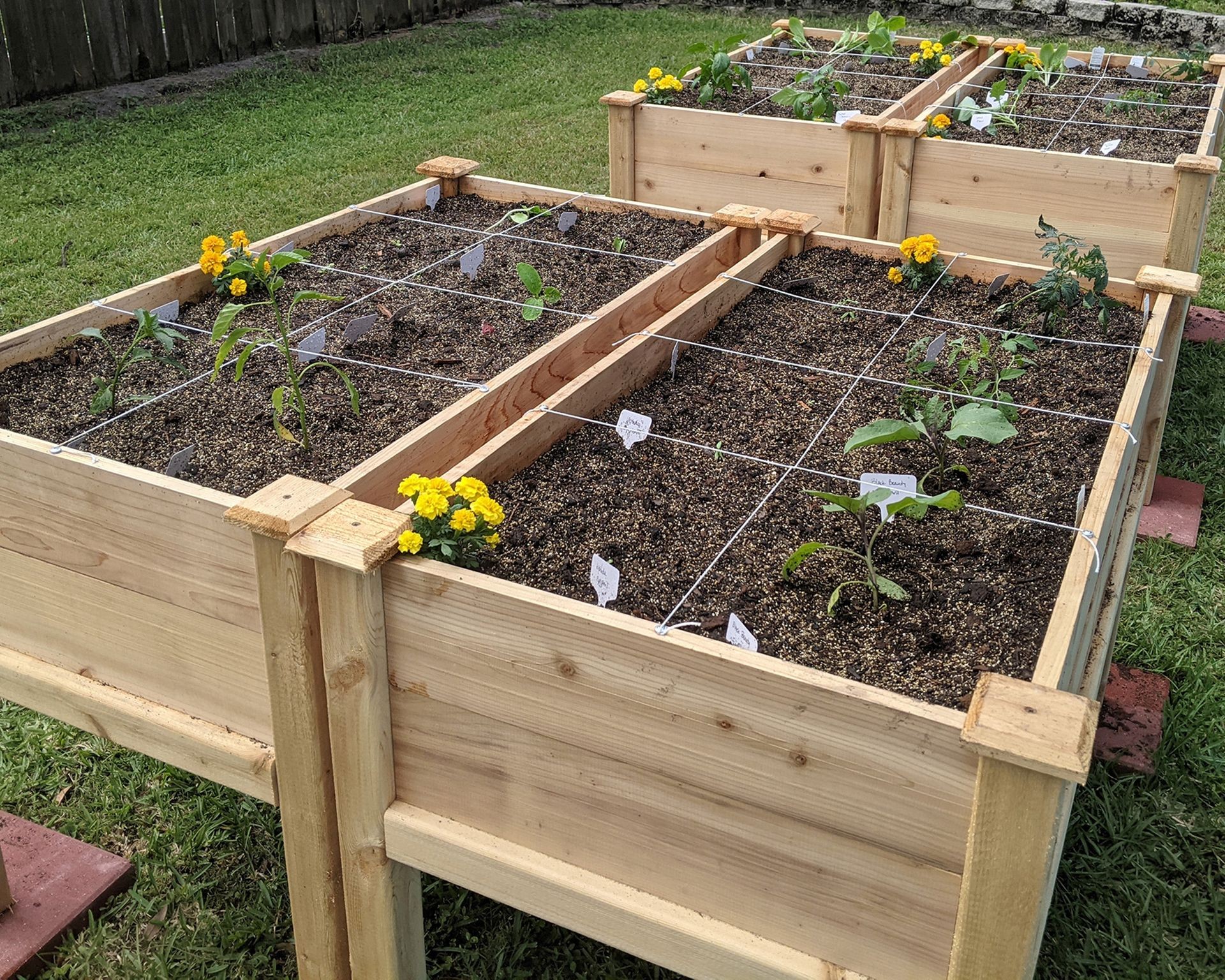 Raised beds divided into a square foot grid for growing vegetables
Raised beds divided into a square foot grid for growing vegetables
Designing and Building Your Square Foot Garden
Setting up your square foot garden is straightforward, starting with the bed itself and its depth.
Bed Dimensions and Type
While the grid is based on 1ft squares, the overall bed size is flexible. Common sizes are 4×4 feet (1.2×1.2m) or 4×8 feet (1.2×2.4m) raised beds, as these dimensions allow easy access to the center from the sides. However, you can adapt the system to any size available space, even a small 2×4 foot bed or a section of an in-ground plot. The key is defining the squares clearly, often with string, wood battens, or even twigs.
Determining Bed Depth
The required depth of your bed depends on the types of plants you plan to grow.
- Shallow-rooted crops: For greens like lettuce, spinach, or radishes, a depth of about 6 inches (15 cm) is sufficient.
- Medium to Deep-rooted crops: Plants like carrots, tomatoes, peppers, and squash need more room for their roots to develop. A depth of 12 inches (30.5 cm) or more is recommended for these.
A significant advantage of raised beds is that you only need to fill or amend the soil to the required depth, which can be more cost-effective than improving a large area of in-ground soil.
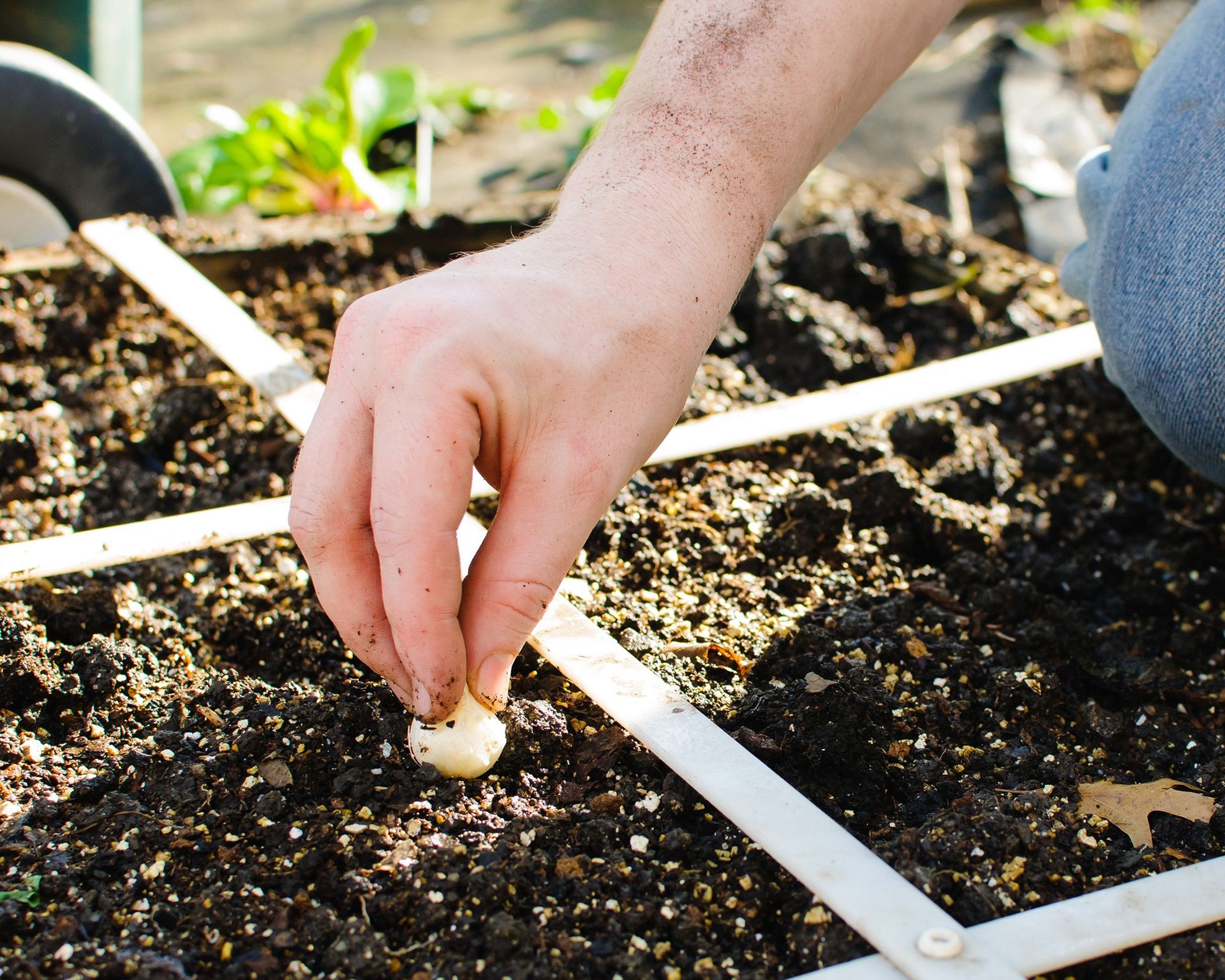 Planting bulbs in a square foot vegetable garden
Planting bulbs in a square foot vegetable garden
Preparing the Foundation: Site and Soil for Success
Choosing the right location and preparing the soil are fundamental steps for a productive square foot garden.
Site Selection
Most vegetables require ample sunlight to thrive. Select a spot that receives at least eight hours of direct sun per day. Ensure it is easily accessible for planting, watering, and harvesting.
Creating the Ideal Soil Mix
The soil in a square foot garden needs to be loose, fertile, and well-draining since it won’t be compacted by foot traffic. Mel Bartholomew popularized a specific mix often referred to as “Mel’s Mix,” known for its excellent drainage, aeration, and fertility.
A common formula for this mix is:
- One-third coarse vermiculite: Improves aeration and moisture retention.
- One-third peat moss (or a sustainable alternative like coco coir): Provides structure and holds water.
- One-third blended compost: The powerhouse for nutrients and beneficial microbes. Use a mix from various sources if possible for a broader nutrient profile.
If you are using existing garden soil in a ground-level plot or as a base layer in a raised bed, it’s crucial to amend it heavily with high-quality compost and other organic matter to improve its structure, drainage, and fertility. Experts agree that building healthy soil is the cornerstone of any successful garden, especially in intensive systems like SFG.
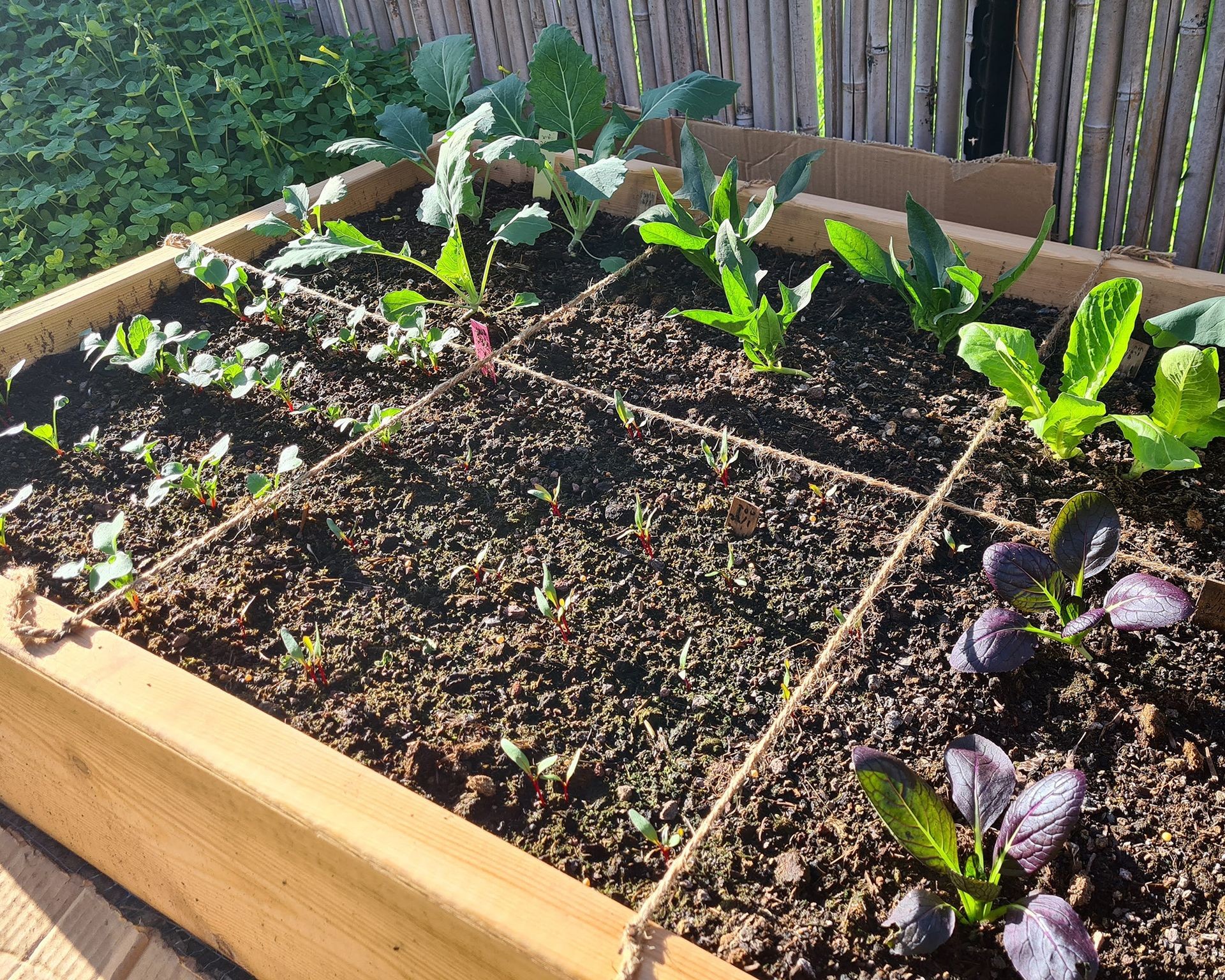 Raised bed divided into square foot grid with string, with perfectly ordered crops
Raised bed divided into square foot grid with string, with perfectly ordered crops
Strategic Planting: How Many Plants Per Square?
This is where the “square foot” concept truly shines. Instead of planting in rows, you plant based on the mature size of the plant within the 1×1 foot grid.
The general rule is that each square will accommodate 1, 4, 9, or 16 plants.
- 1 plant per square: Large plants that need significant space, such as tomatoes, peppers, broccoli, eggplant, cabbage, or zucchini. Vining plants like cucumbers or pole beans often get 1-2 plants per square and are trained vertically.
- 4 plants per square: Medium-sized plants like lettuce (head varieties), spinach, bush beans, or corn (though corn requires multiple squares for pollination).
- 9 plants per square: Smaller plants like beets, bunching onions, garlic, leeks, or smaller salad greens.
- 16 plants per square: Tiny plants like radishes, carrots, or onions (sets).
To determine the exact number for a specific crop, consult the seed packet for recommended spacing. As a rule of thumb, if the seed packet recommends spacing of 12 inches, you plant 1 per square. If it recommends 6 inches, you can plant 4 (two rows of two). For 4-inch spacing, you can plant 9 (three rows of three). For 3-inch spacing, you can plant 16 (four rows of four).
Choosing What to Plant and When
Variety is the spice of life, and your square foot garden can host a wide range of crops throughout the year by understanding planting seasons.
Adapting to Seasons
- Cool-Season Crops: Plant these in early spring and again in the fall. Examples include lettuce, spinach, kale, radishes, carrots, beets, peas, broccoli, and cabbage.
- Warm-Season Crops: Plant these after all danger of frost has passed in your area and the soil has warmed up. Examples include tomatoes, peppers, eggplant, squash, zucchini, cucumbers, beans, and corn.
Integrating annual herbs like basil, cilantro, or parsley into empty spaces within squares can also increase your garden’s diversity and productivity.
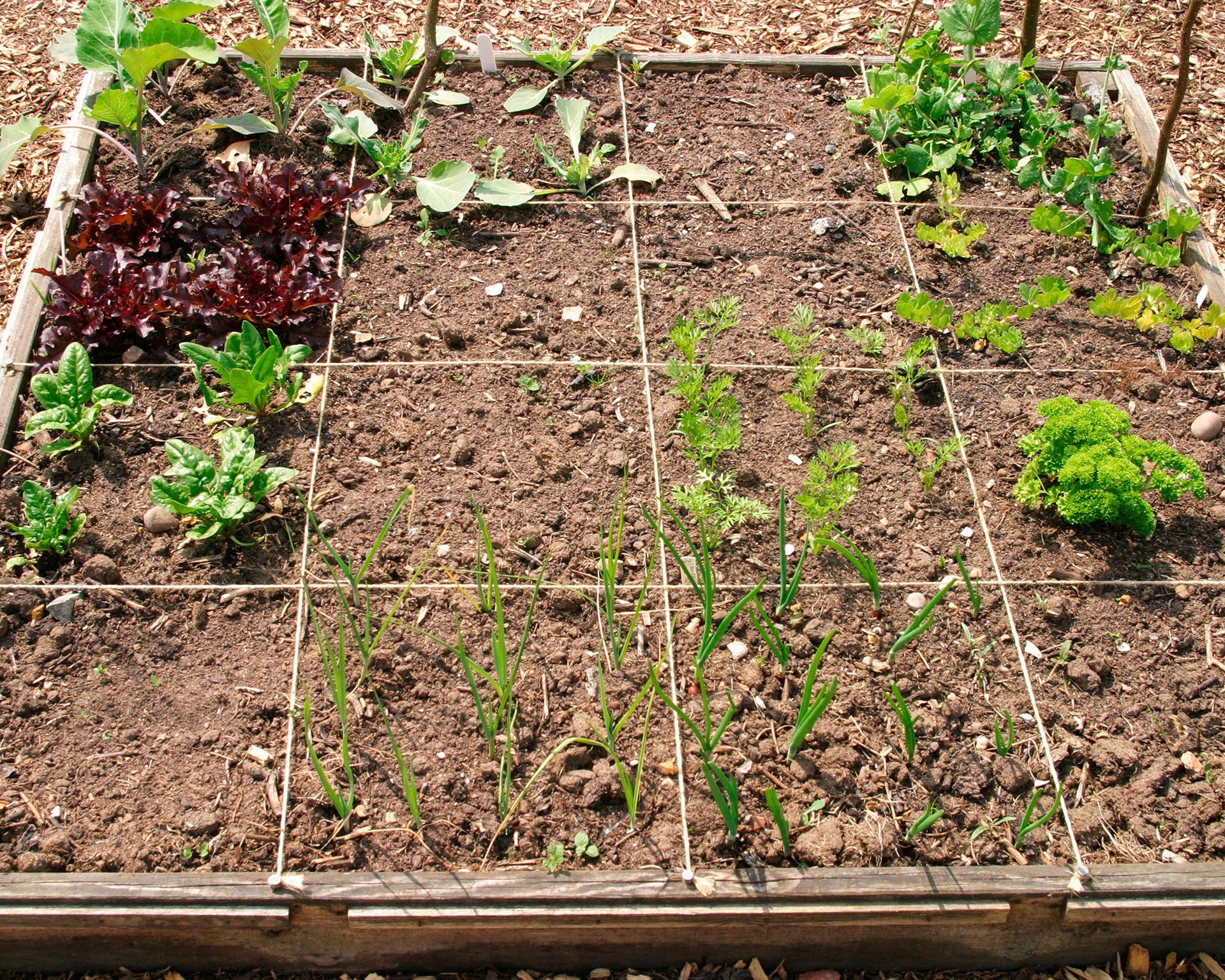 Vegetable garden divided into sections with string
Vegetable garden divided into sections with string
Maximizing Yield with Succession Planting
One of the most powerful techniques to boost your total harvest from a square foot garden is succession planting. This involves planting new seeds or seedlings in a square as soon as the previous crop has finished producing and been harvested.
For example, after harvesting a quick crop of radishes from a square (which take only about 3-4 weeks), you can immediately replant that square with something else appropriate for the season – perhaps more radishes, a few spinach plants, or if the season is right, a cucumber or tomato seedling in a nearby square that was designated for larger plants. When a square of lettuce is harvested, you might replace it with bush beans or carrots, depending on the time of year. This continuous rotation keeps your garden producing food throughout the growing season and beyond.
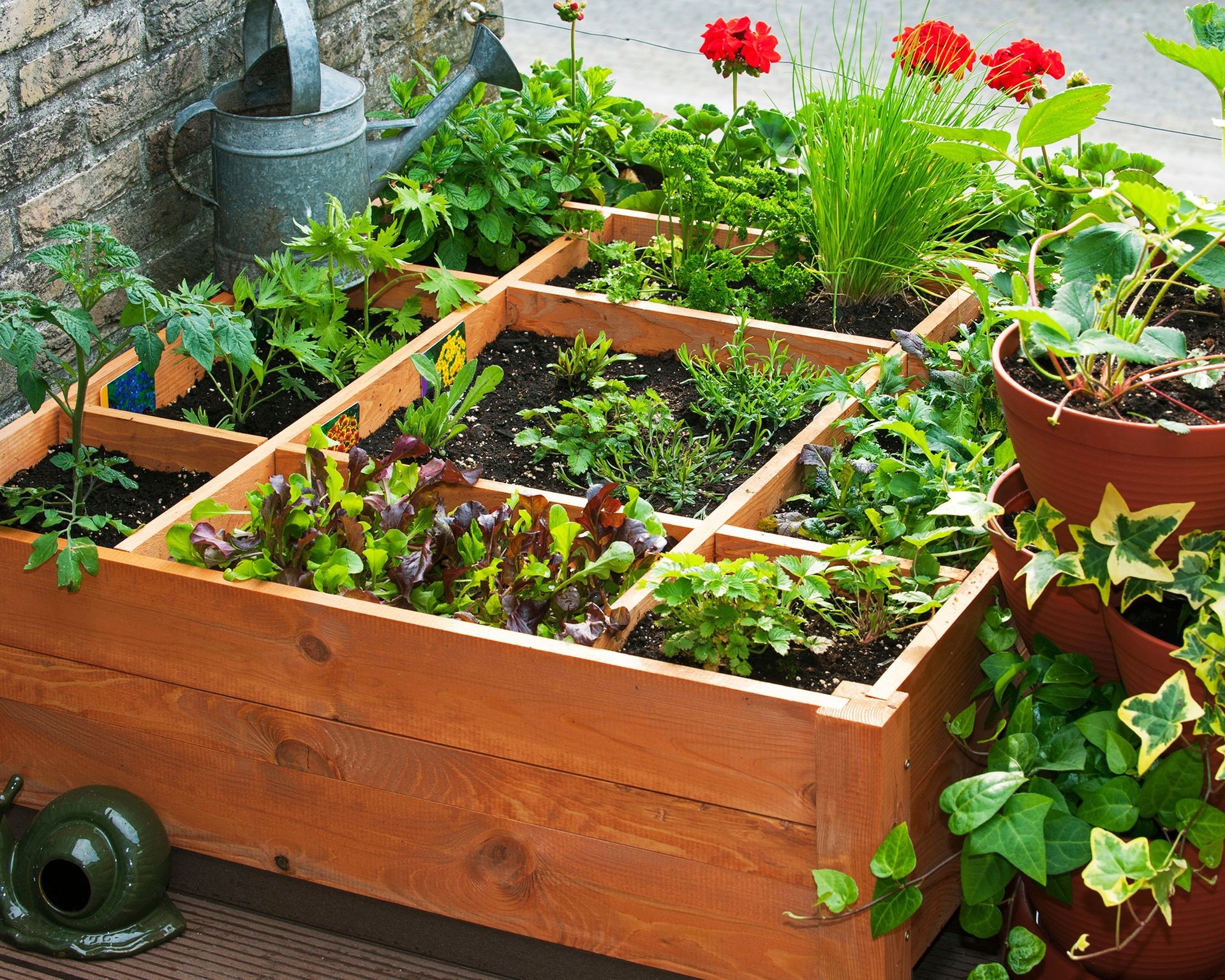 Raised bed divided into grids, growing salad and vegetable crops alongside flowers
Raised bed divided into grids, growing salad and vegetable crops alongside flowers
Example: A Sample 4×4 Square Foot Garden Layout
Here’s a possible layout for a 4×4 foot garden bed (16 squares), demonstrating the variety you can achieve:
- Square 1: 1 Broccoli
- Square 2: 1 Eggplant
- Square 3: 1 Pepper
- Square 4: 1 Tomato
- Square 5: 1 Zucchini
- Square 6 & 7: 2 Cucumbers (trained vertically)
- Square 8: 4 Arugula plants
- Square 9 & 10: 4 Corn plants each (total 8, need multiple squares for pollination)
- Square 11: 6 Lettuce plants (leaf or small head varieties)
- Square 12: 9 Beets
- Square 13: 9 Bunching onions
- Square 14: 9 Garlic (planted in fall for summer harvest) or Leeks
- Square 15: 9 Turnips
- Square 16: 16 Carrots
Remember, plants like large squash or melons might require two or even four squares to accommodate their sprawling vines, unless trained vertically. By planning carefully and utilizing succession planting, you can keep this 4×4 bed producing an incredible amount of food from spring through fall, and even into winter in some climates with protection.
Conclusion: Embrace the Efficiency of Square Foot Gardening
Square foot gardening offers a powerful, efficient, and highly rewarding way to grow a diverse range of vegetables, herbs, and even some fruits, regardless of the size of your gardening space. By focusing on intensive planting in defined areas, you save time, water, and effort while enjoying impressive yields. It’s a systematic approach that simplifies gardening, making it accessible and enjoyable for everyone.
Ready to maximize your harvest in minimal space? Consider implementing the square foot gardening method in your yard or balcony. Explore the range of high-quality soil amendments and organic fertilizers available from Biogarden.asia to give your square foot garden the best possible start. Share your square foot gardening journey and successes with our community!



